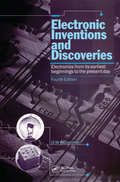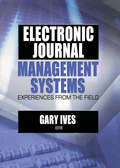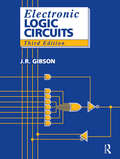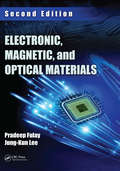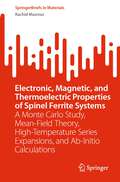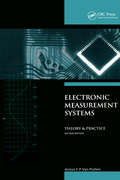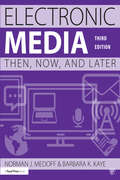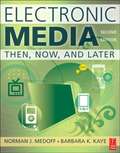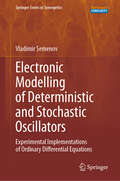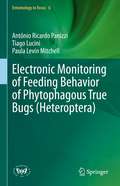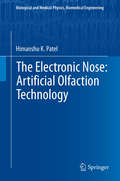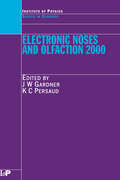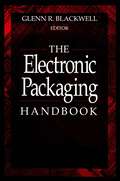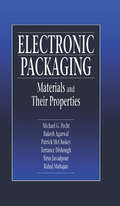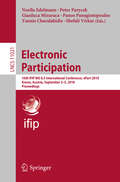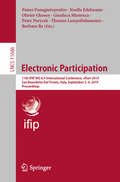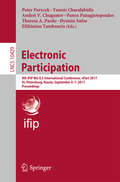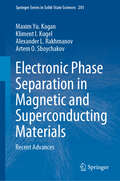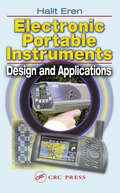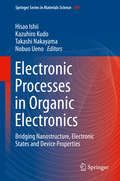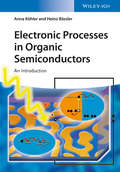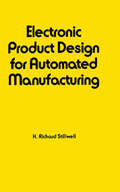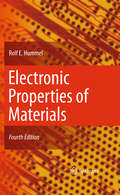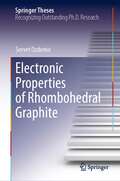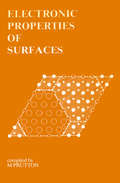- Table View
- List View
Electronic Inventions and Discoveries: Electronics from its earliest beginnings to the present day, Fourth Edition
by G.W.A DrummerIn a remarkably short time, electronics has penetrated almost every aspect of modern life and the pace of development in the field shows no sign of slackening. One of the first books to cover electronic inventions in depth, Electronic Inventions and Discoveries: Electronics from Its Earliest Beginnings to the Present Day, Fourth Edition traces the development of electronics from its earliest beginnings to the present day. Spanning a period of two and a half centuries, the book presents a mini-encyclopedia full of valuable information on practically all inventions in electronics from 1745 to 1996. This fourth edition has been brought up-to-date and made more attractive by a complete redesign while still maintaining the successful features of previous editions. The first nine chapters supply concise yet comprehensive histories of the main areas of the subject. Subsequent chapters provide a list of inventions by subject and succinct descriptions of each invention in date order with over 1,000 references. The book concludes with a list of acronyms and abbreviations, a list of books on inventions and inventors, and a comprehensive index.During his seventy years in the field, the author has collected a variety of published data to form an up-to-date systematic review of the major developments in electronics and the pattern of advances in electronic techniques. The book forms an essential source of reference to practicing engineers wishing to broaden their knowledge. Teachers and students who require a sound background and understanding of electronics will also find the book invaluable. Written in an easily understood largely nontechnical language, this fascinating and authoritative history of electronic developments will be of great interest to electronic hobbyists and general science readers.
Electronic Journal Management Systems: Experiences from the Field
by Gary W IvesDiscover how to manage your library&’s electronic journals-with tips from those who&’ve already met the challenge!The explosive growth of electronic journals presents unique challenges for libraries. Electronic Journal Management Systems: Experiences from the Field comprehensively examines these complex topics, including explanations of the automated systems libraries have developed or adopted, licensing issues, and the provision of access to electronic journals. Respected library professionals discuss their own experiences in the implementation and use of electronic journal management systems, helping readers to easily apply effective strategies in their own library.Electronic Journal Management Systems: Experiences from the Field reveals the available technologies, difficulties encountered, and successes of different librarians who met the challenge to implement management systems, giving readers an inside glimpse of what they themselves may encounter when planning their own system. The growth of electronic journals in libraries is addressed, along with helpful descriptions of management systems and link resolvers, including systems like SFX, Serial Solutions, TDNet, and EBSCO LinkSource. The book includes screen shots, tables, and diagrams to clearly illustrate concepts and information.Electronic Journal Management Systems: Experiences from the Field discusses a wide range of implementation and use issues, including: using Microsoft Excel to manage serial subscriptions better integration of management of electronic resources through library vendors one-stop serials management and access the selection process of a journal management system the preparation for implementation and subsequent transition process the Web site as a listing and finding tool the benefits of switching to an SFX environment creating a customized database for multiple systems the Innovative Interfaces, Inc. partnership with libraries to develop a module to manage electronic resources based on the work of the Digital Library Federation&’s Electronic Resources Management Initiative the evaluation and implementation process of a beta test library with an integrated library system vendor to develop a management system developing a universal management scheme for electronic resources Electronic Journal Management Systems: Experiences from the Field brings the latest strategies, technologies, and cutting-edge ideas to every library professional grappling with ways to manage the flow of electronic journals in a library.
Electronic Logic Circuits
by J. GibsonMost branches of organizing utilize digital electronic systems. This book introduces the design of such systems using basic logic elements as the components. The material is presented in a straightforward manner suitable for students of electronic engineering and computer science. The book is also of use to engineers in related disciplines who require a clear introduction to logic circuits. This third edition has been revised to encompass the most recent advances in technology as well as the latest trends in components and notation. It includes a wide coverage of application specific integrated circuits (ASCIs), many worked examples and a step-by-step logical and practical approach.
Electronic, Magnetic, and Optical Materials
by Pradeep Fulay Jung-Kun LeeThis book integrates materials science with other engineering subjects such as physics, chemistry and electrical engineering. The authors discuss devices and technologies used by the electronics, magnetics and photonics industries and offer a perspective on the manufacturing technologies used in device fabrication. The new addition includes chapters on optical properties and devices and addresses nanoscale phenomena and nanoscience, a subject that has made significant progress in the past decade regarding the fabrication of various materials and devices with nanometer-scale features.
Electronic, Magnetic, and Thermoelectric Properties of Spinel Ferrite Systems: A Monte Carlo Study, Mean-Field Theory, High-Temperature Series Expansions, and Ab-Initio Calculations (SpringerBriefs in Materials)
by Rachid MasrourThis book explores magnetic properties and critical temperatures in inverse ferrite Fe₃⁺(M₂⁺Fe₃⁺)O₄ spinels (e.g., Fe, Co, Ni). It calculates transition and Curie Weiss temperatures, providing insights into their thermodynamic behavior. Using the full potential linearized augmented plane wave (FP-LAPW) method, it investigates electrical and magnetic structures of spinel chromite, revealing magnetic moments in MnCr₂S₄. Seebeck coefficient and electrical conductivity are also calculated. Advanced techniques like Monte Carlo, DFT+U, and FLAPW analyze magnetic characteristics of LiMn₁.₅Ni₀.₅O₄ and electronic/magnetic structures of Fe₃O₄. High-temperature series expansions calculate Néel temperature and critical exponents, while GFT determines thermal magnetization and susceptibility. The analysis exposes exchange interactions' effects on magnetic order and introduces asymmetric phases in ferrimagnetic spinel systems. This book serves as an invaluable resource for researchers, academics, and enthusiasts seeking a comprehensive understanding of magnetic properties and critical phenomena within diverse spinel materials.
Electronic Measurement Systems: Theory and Practice
by A.F.P Van PuttenElectronic Measurement Systems: Theory and Practice, Second Edition is designed for those who require a thorough understanding of the wide variety of both digital and analogue electronic measurement systems in common use. The first part of the book discusses basic concepts such as system specification, architectures, structures, and components. Later chapters cover topics important for the proper functioning of systems including reliability, guarding/shielding, and noise. Finally, an unusual chapter treats the problems of the human aspects of the design of measurement systems. The book also includes problems and exercises.New to the Second Edition Extended section about signal structures, I/O bussystems, DAQ boards, and their architecture User programmable devices (UPLD's) and the use of microprocessor principles in instrumentation Novel approaches on reliability due to built-in testability becoming a major design feature A brief introduction to the related physics of each transducer energy domain to understand what the principle of operation is Discussion of the ADM method for drift elimination Introduction to the European Electro Magnetic Compatibility legislation and the ISO 9000 system Additional noise calculation techniques and noise in sensors Chapter on autozeroing transducers and sensor interfacing, paying particular attention to bridge circuits for modulating transducers
Electronic Media: Then, Now, and Later
by Barbara Kaye Norman J. MedoffElectronic Media: Then, Now, and Later provides a synopsis of the beginnings of electronic media in broadcasting and the subsequent advancements into digital media. The Then, Now, and Later approach focuses on how past innovations laid the groundwork for changing trends in technology, providing the opportunity and demand for evolution in both broadcasting and digital media. An updated companion website provides links to additional resources, chapter summaries, study guides and practice quizzes, instructor materials, and more. This new edition features two new chapters: one on social media, and one on choosing your entertainment and information experience. The then/now/later thematic structure of the book helps instructors draw parallels (and contracts) between media history and current events, which helps get students more engaged with the material. The book is known for its clear, concise, readable, and engaging writing style, which students and instructors alike appreciate. The companion website is updated and offers materials for instructors (an IM, PowerPoint slides, and test bank)
Electronic Media: Then, Now, And Later (Second Edition)
by Norman Medoff Barbara K. KayeElectronic Media connects the traditional world of broadcasting with the contemporary universe of digital electronic media. It provides a synopsis of the beginnings of electronic media in broadcasting, and the subsequent advancements into digital media. Underlying the structure of the book is a "See It Then, See It Now, See It Later" approach that focuses on how past innovations lay the groundwork for changing trends in technology, providing the opportunity and demand for change in both broadcasting and digital media. FYI and Zoom-In boxes point to further information, tying together the immediate and long-ranging issues surrounding electronic media. Career Tracks feature the experiences of industry experts and share tips in how to approach this challenging industry.
Electronic Modelling of Deterministic and Stochastic Oscillators: Experimental Implementations of Ordinary Differential Equations (Springer Series in Synergetics)
by Vladimir SemenovThis book presents advanced methods for the electronic modeling of dynamical systems governed by ordinary differential equations. It offers a comprehensive toolkit and practical solutions for specialists in nonlinear dynamics who seek experimental validation of their mathematical models. The aim is to empower readers without an extensive background in electronics or circuit theory to translate their theoretical concepts into real-world devices, facilitating the rapid experimental confirmation of numerical and theoretical findings. For experts in electronic engineering, the book showcases how a wide range of non-electronic systems and their unique characteristics can be effectively modeled using electronic circuits. Bridging the gap between theory and practice, the book serves as a valuable resource on electronics for theorists and mathematicians, and on nonlinear dynamics for experimentalists and engineers. Its audience includes a broad spectrum of readers, from students and engineers to scientists and researchers across various fields.
Electronic Monitoring of Feeding Behavior of Phytophagous True Bugs (Entomology in Focus #6)
by Antônio Ricardo Panizzi Tiago Lucini Paula Levin MitchellThis book compiles for the first time all the current information on the electronic monitoring of the feeding behavior of phytophagous true bugs. It includes state-of-the-art illustrations of feeding sites on the various plant structures, and examines how the different feeding strategies are related to the variable waveforms generated using the electropenetrography (EPG) technique. Further, the book describes the mouthparts and modes of feeding and discusses the physical and chemical damage resulting from feeding activities. Covering in detail all EPG studies developed and conducted using true bugs published to date, it explores the use of electronic monitoring of feeding coupled with histological analyses to improve strategies to control true bugs, from traditional chemical methods to gene silencing (RNAi).
The Electronic Nose: Artificial Olfaction Technology
by Himanshu K. PatelThis book provides the basics of odor, odor analysis techniques, sensors used in odor analysis and overview of odor measurement techniques. For beginners as well researchers this book is a brief guide for odor measurement and analysis. The book includes a special chapter dedicated to practical implementation of e-nose sensor devices with software utility, which guides students to prepare projects and work in practical analysis. It also includes material from early to latest technology research available in the market of e-nose era. Students and researchers who want to learn the basics of biomedical engineering and sensor measurement technology will find this book useful.
Electronic Noses and Olfaction 2000: Proceedings of the 7th International Symposium on Olfaction and Electronic Noses, Brighton, UK, July 2000 (Series in Sensors)
by Julian W. Gardner Krishna C. PersaudElectronic Noses and Olfaction 2000 reflects the state of progress toward the development and application of electronic instruments called electronic noses (e-noses). These instruments are generally based on arrays of sensors for volatile chemicals with broadly tuned selectivity, coupled to appropriate pattern recognition systems. They are capable
The Electronic Packaging Handbook (Electronics Handbook Series)
by G. R. BlackwellThe packaging of electronic devices and systems represents a significant challenge for product designers and managers. Performance, efficiency, cost considerations, dealing with the newer IC packaging technologies, and EMI/RFI issues all come into play. Thermal considerations at both the device and the systems level are also necessary.The Electronic Packaging Handbook, a new volume in the Electrical Engineering Handbook Series, provides essential factual information on the design, manufacturing, and testing of electronic devices and systems.Co-published with the IEEE, this is an ideal resource for engineers and technicians involved in any aspect of design, production, testing or packaging of electronic products, regardless of whether they are commercial or industrial in nature. Topics addressed include design automation, new IC packaging technologies, materials, testing, and safety.Electronics packaging continues to include expanding and evolving topics and technologies, as the demand for smaller, faster, and lighter products continues without signs of abatement. These demands mean that individuals in each of the specialty areas involved in electronics packaging-such as electronic, mechanical, and thermal designers, and manufacturing and test engineers-are all interdependent on each others knowledge. The Electronic Packaging Handbook elucidates these specialty areas and helps individuals broaden their knowledge base in this ever-growing field.
Electronic Packaging Materials and Their Properties (Electronic Packaging)
by Michael Pecht Rakish Agarwal F. Patrick McCluskey Terrance J. Dishongh Sirus Javadpour Rahul MahajanPackaging materials strongly affect the effectiveness of an electronic packaging system regarding reliability, design, and cost. In electronic systems, packaging materials may serve as electrical conductors or insulators, create structure and form, provide thermal paths, and protect the circuits from environmental factors, such as moisture, contamination, hostile chemicals, and radiation.Electronic Packaging Materials and Their Properties examines the array of packaging architecture, outlining the classification of materials and their use for various tasks requiring performance over time. Applications discussed include:interconnectionsprinted circuit boardssubstratesencapsulantsdielectricsdie attach materialselectrical contactsthermal materialssoldersElectronic Packaging Materials and Their Properties also reviews key electrical, thermal, thermomechanical, mechanical, chemical, and miscellaneous properties as well as their significance in electronic packaging.
Electronic Participation: 10th IFIP WG 8.5 International Conference, ePart 2018, Krems, Austria, September 3-5, 2018, Proceedings (Lecture Notes in Computer Science #11021)
by Noella Edelmann Peter Parycek Gianluca Misuraca Panos Panagiotopoulos Yannis Charalabidis Shefali VirkarThis book constitutes the proceedings of the 10th IFIP WG 8.5 International Conference on Electronic Participation, ePart 2018, held in Krems, Austria, in September 2018.The 12 revised full papers presented in this book were carefully reviewed and selected from 29 submissions. The papers are clustered under the following topical sections: general e-democracy and e-participation; digital collaboration and social media; policy modeling and policy informatics; and social innovation.
Electronic Participation: 11th IFIP WG 8.5 International Conference, ePart 2019, San Benedetto Del Tronto, Italy, September 2–4, 2019, Proceedings (Lecture Notes in Computer Science #11686)
by Panos Panagiotopoulos Noella Edelmann Olivier Glassey Gianluca Misuraca Peter Parycek Thomas Lampoltshammer Barbara ReThis book constitutes the proceedings of the 11th IFIP WG 8.5 International Conference on Electronic Participation, ePart 2019, held in San Benedetto del Tronto, Italy, in September 2019, in conjunction with the 18th IFIP WG 8.5 IFIP International Conference on Electronic Government (EGOV 2019) and the International Conference for E-Democracy and Open Government Conference (CeDEM 2019).The 13 revised full papers presented were carefully reviewed and selected from 26 submissions. The papers are clustered under the following topical sections: eParticipation Developments; Digital Transformations; Crisis and Emergency Management; and User Perspectives.
Electronic Participation: 9th IFIP WG 8.5 International Conference, ePart 2017, St. Petersburg, Russia, September 4-7, 2017, Proceedings (Lecture Notes in Computer Science #10429)
by Peter Parycek, Yannis Charalabidis, Andrei V. Chugunov, Panos Panagiotopoulos, Theresa A. Pardo, Øystein Sæbø and Efthimios TambourisThis book constitutes the proceedings of the 9th IFIP WG 8.5 International Conference on Electronic Participation, ePart 2017, held in St. Petersburg, Russia, in September 2017.The 11 revised full papers presented in this book were carefully reviewed and selected from 14 submissions. The papers reflect completed multi-disciplinary research ranging from policy analysis and conceptual modeling to programming and visualization of simulation models. They are organized in four topical threads: methodological issues in e-participation; e-participation implementations; policy modeling and policy informatics; critical reflections.
Electronic Phase Separation in Magnetic and Superconducting Materials: Recent Advances (Springer Series in Solid-State Sciences #201)
by Maxim Yu. Kagan Kliment I. Kugel Alexander L. Rakhmanov Artem O. SboychakovThis book focuses on nanoscale electronic phase separation in a wide class of different materials, especially in strongly correlated electron systems. It features an extensive review of the field of inhomogeneous spin and charge states in condensed matter physics while delivering a topical and timely discussion of a wide range of recent advances in electronic phase separation. It describes the formation of different types of nanoscale ferromagnetic metallic droplets in antiferromagnetically ordered, charge-ordered, or orbitally-ordered insulating matrices, as well as the colossal magnetoresistance effect and tunneling electron transport in the nonmetallic phase-separated state of complex magnetic oxides. It also discusses compounds with spin-state transitions, inhomogeneously phase-separated states in strongly correlated multiband systems, and the electron polaron effect, paying special attention to systems with imperfect Fermi surface-nesting such as chromium alloys, iron-based pnictides, and AA-stacked graphene bilayers. The authors investigate also the formation of order parameter clusters and insulator-superconductor transition in different superconducting systems including bismuth oxides, two-dimensional films in the presence of strong disorder, as well as inhomogeneous Fermi-Bose mixtures in Aharonov-Bohm rings with a superconducting bridge in a topologically nontrivial state. This book is a valuable resource for researchers involved in theoretical and experimental studies of strongly correlated materials, such as magnetic semiconductors, Fermi-Bose mixtures, and twisted bilayer graphene.
Electronic Portable Instruments: Design and Applications
by Halit ErenWith the availability of advanced technologies, digital systems, and communications, portable instruments are rapidly evolving from simple, stand alone, low-accuracy measuring instruments to complex multifunctional, network integrated, high-performance digital devices with advanced interface capabilities. The relatively brief treatments these instr
Electronic Processes in Organic Electronics
by Hisao Ishii Kazuhiro Kudo Takashi Nakayama Nobuo UenoThe book covers a variety of studies of organic semiconductors, from fundamental electronic states to device applications, including theoretical studies. Furthermore, innovative experimental techniques, e. g. , ultrahigh sensitivity photoelectron spectroscopy, photoelectron yield spectroscopy, spin-resolved scanning tunneling microscopy (STM), and a material processing method with optical-vortex and polarization-vortex lasers, are introduced. As this book is intended to serve as a textbook for a graduate level course or as reference material for researchers in organic electronics and nanoscience from electronic states, fundamental science that is necessary to understand the research is described. It does not duplicate the books already written on organic electronics, but focuses mainly on electronic properties that arise from the nature of organic semiconductors (molecular solids). The new experimental methods introduced in this book are applicable to various materials (e. g. , metals, inorganic and organic materials). Thus the book is also useful for experts working in physics, chemistry, and related engineering and industrial fields.
Electronic Processes in Organic Semiconductors
by Heinz Bässler Anna KöhlerThe first advanced textbook to provide a useful introduction in a brief, coherent and comprehensive way, with a focus on the fundamentals. After having read this book, students will be prepared to understand any of the many multi-authored books available in this field that discuss a particular aspect in more detail, and should also benefit from any of the textbooks in photochemistry or spectroscopy that concentrate on a particular mechanism. Based on a successful and well-proven lecture course given by one of the authors for many years, the book is clearly structured into four sections: electronic structure of organic semiconductors, charged and excited states in organic semiconductors, electronic and optical properties of organic semiconductors, and fundamentals of organic semiconductor devices.
Electronic Product Design for Automated Manufacturing
by Richard StillwellAnalyzes all phases of the electronic product design process, including management, planning, quality control, design, manufacturing, and automation. A reference/textbook for students and professionals in such fields as electronics, manufacturing, circuit design, computer science. Annotation copyrig
Electronic Properties of Materials: An Introduction Engineers
by Rolf E. HummelThis text on the electrical, optical, magnetic, and thermal properties of materials stresses concepts rather than mathematical formalism. Suitable for advanced undergraduates, it is intended for materials and electrical engineers who want to gain a fundamental understanding of alloys, semiconductor devices, lasers, magnetic materials, and so forth. The book is organized to be used in a one-semester course; to that end each section of applications, after the introduction to the fundamentals of electron theory, can be read independently of the others. Many examples from engineering practice serve to provide an understanding of common devices and methods. Among the modern applications covered are: high-temperature superconductors, optoelectronic materials, semiconductor device fabrication, xerography, magneto-optic memories, and amorphous ferromagnetics. The fourth edition has been revised and updated with an emphasis on the applications sections, which now cover devices of the next generation of electronics.
Electronic Properties of Rhombohedral Graphite (Springer Theses)
by Servet OzdemirThis thesis presents the first systematic electron transport investigation of rhombohedral graphite (RG) films and thus lies at the interface of graphene physics, vdW heterostructure devices and topological matter. Electron transport investigation into the rhombohedral phase of graphite was limited to a few layers of graphene due to the competing hexagonal phase being more abundant. This work reports that in exfoliated natural graphite films, rhombohedral domains of up to 50 layers can be found. In the low energy limit, these domains behave as an N-layer generalisation of graphene. Moreover, being a potential alternative to twisted bilayer graphene systems, RG films show a spontaneous metal-insulator transition, with characteristic symmetry properties that could be described by mean-field theory where superconductivity is also predicted in these low energy bands. A nodal-line semimetal in the bulk limit, RG thin films are a 3D generalisation of the simplest topological insulator model: the Su-Schrieffer-Heeger chain. Similar to the more usual topological insulators, RG films exhibit parallel conduction of bulk states, which undergo three-dimensional quantum transport that reflects bulk topology.
Electronic Properties of Surfaces
by PruttonIn recent years the availability of techniques and the asking of basic and technological questions has led to an international explosion of activity in the study of solid surfaces. Originally published in Reports in Progress in Physics, Electronic Properties of Surfaces reflects the modern knowledge in this field, presenting critical appraisals of progress in surface science. The book should be particularly valuable for researchers new to this field.
